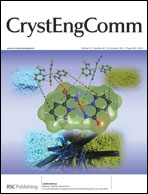Self-assembly of metal–organic frameworks based on N-donor ligand and flexible tricarboxylic acids with different angular characters†
Abstract
Five metal–organic frameworks (MOFs), namely, [Zn2(L1)(BIMB)(μ2-OH)] (1), [Zn3(L1)2(BIMB)3]·4H2O (2), [Zn(HL2)(BIMB)0.5]·H2O (3), [Zn3(L2)2(BIMB)3]·8H2O (4) and [Zn3(L2)2(BIMB)3]·4H2O (5) (H3L1 = 5-(3-carboxybenzyloxy)isophthalic acid, H3L2 = 5-(4-carboxybenzyloxy)isophthalic acid and BIMB = 1,4-di(1H-imidazol-1-yl)benzene), have been synthesized under hydrothermal conditions. Their structures have been determined by single-crystal X-ray diffraction analyses and further characterized by elemental analyses, IR spectra, and thermogravimetric (TG) analyses. Complex 1 is a (3,4)-connected 3D interlocking polycatenated framework with the (63)(66) topology by 2D parallel interpenetration. Complex 2 adopts a self-penetrating 3D (3,4)-connected network with (6·82)(4·6·8)(6·84·9)(4·62·82·10) topology, which contains rotaxane- and catenane-like motifs together. Complex 3 is a 3D supramolecular structure formed by hydrogen bonds between adjacent 2D (4,4) sheets. For complex 4, it shows a three-folded 3D framework by a (3,4)-connected net with (62·8)(4·6·8)(63·7·8·9)(4·62·72·8)(62·72·92) topology. Complex 5 is a (3,4)-connected 3D framework. We have discussed the influence of synthetic conditions and different carboxylate ligands on the final structures. In addition, powder X-ray diffraction and photoluminescent properties for 1–5 have been studied in detail at room temperature.


 Please wait while we load your content...
Please wait while we load your content...